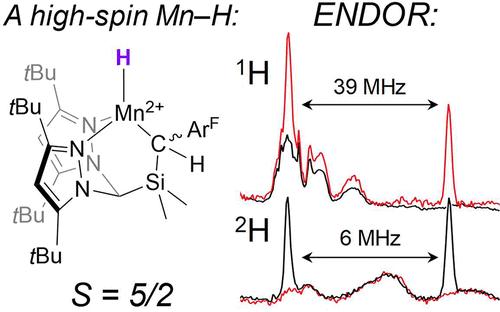当前位置:
X-MOL 学术
›
J. Am. Chem. Soc.
›
论文详情
Our official English website, www.x-mol.net, welcomes your feedback! (Note: you will need to create a separate account there.)
Terminal Hydride Complex of High-Spin Mn
Journal of the American Chemical Society ( IF 14.4 ) Pub Date : 2024-06-28 , DOI: 10.1021/jacs.4c03310 Alex Drena 1 , Addison Fraker 2 , Niklas B. Thompson 3 , Peter E. Doan 1 , Brian M. Hoffman 1 , Alex McSkimming 2
Journal of the American Chemical Society ( IF 14.4 ) Pub Date : 2024-06-28 , DOI: 10.1021/jacs.4c03310 Alex Drena 1 , Addison Fraker 2 , Niklas B. Thompson 3 , Peter E. Doan 1 , Brian M. Hoffman 1 , Alex McSkimming 2
Affiliation

|
The iron–molybdenum cofactor of nitrogenase (FeMoco) catalyzes fixation of N2 via Fe hydride intermediates. Our understanding of these species has relied heavily on the characterization of well-defined 3d metal hydride complexes, which serve as putative spectroscopic models. Although the Fe ions in FeMoco, a weak-field cluster, are expected to adopt locally high-spin Fe2+/3+ configurations, synthetically accessible hydride complexes featuring d5 or d6 electron counts are almost exclusively low-spin. We report herein the isolation of a terminal hydride complex of four-coordinate, high-spin (d5; S = 5/2) Mn2+. Electron paramagnetic resonance and electron–nuclear double resonance studies reveal an unusually large degree of spin density on the hydrido ligand. In light of the isoelectronic relationship between Mn2+ and Fe3+, our results are expected to inform our understanding of the valence electronic structures of reactive hydride intermediates derived from FeMoco.
中文翻译:

高自旋锰的末端氢化物配合物
固氮酶的铁钼辅因子 (FeMoco) 通过 Fe 氢化物中间体催化 N 2 的固定。我们对这些物种的理解在很大程度上依赖于明确定义的 3d 金属氢化物配合物的表征,这些配合物可作为假定的光谱模型。尽管 FeMoco(弱场簇)中的 Fe 离子预计会采用局部高自旋 Fe 2+/3+ 构型,但可合成的氢化物配合物具有 d 5 或 d 6 ; S = 5/2) Mn 2+ 末端氢化物配合物的分离。电子顺磁共振和电子核双共振研究揭示了氢配体上异常大的自旋密度。鉴于 Mn 2+ 和 Fe 3+ 之间的等电子关系,我们的结果有望帮助我们理解 FeMoco 衍生的反应性氢化物中间体的价电子结构。
更新日期:2024-06-28
中文翻译:

高自旋锰的末端氢化物配合物
固氮酶的铁钼辅因子 (FeMoco) 通过 Fe 氢化物中间体催化 N 2 的固定。我们对这些物种的理解在很大程度上依赖于明确定义的 3d 金属氢化物配合物的表征,这些配合物可作为假定的光谱模型。尽管 FeMoco(弱场簇)中的 Fe 离子预计会采用局部高自旋 Fe 2+/3+ 构型,但可合成的氢化物配合物具有 d 5 或 d 6 ; S = 5/2) Mn 2+ 末端氢化物配合物的分离。电子顺磁共振和电子核双共振研究揭示了氢配体上异常大的自旋密度。鉴于 Mn 2+ 和 Fe 3+ 之间的等电子关系,我们的结果有望帮助我们理解 FeMoco 衍生的反应性氢化物中间体的价电子结构。











































 京公网安备 11010802027423号
京公网安备 11010802027423号